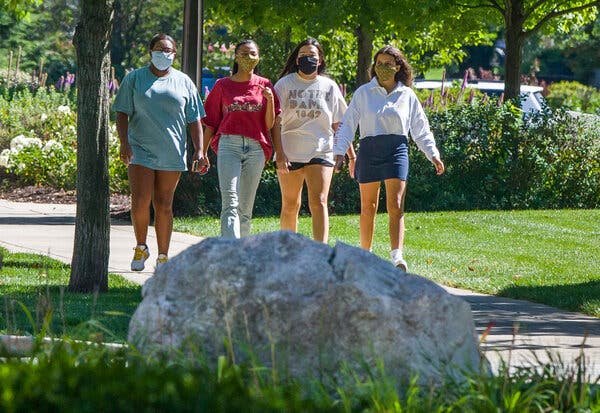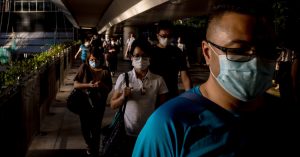This is the Coronavirus Schools Briefing, a guide to the seismic changes in U.S. education that are taking place during the pandemic. Sign up here to get the briefing by email.
State of Play: Colleges and Universities
In a matter of days, nearly all U.S. colleges and universities will be back in session — whether it’s online, in person, or some combination. Davidson College and The Chronicle of Higher Education are tracking the reopening plans of nearly 3,000 institutions:
-
6 percent will be online-only
-
27 percent will be primarily online
-
15 percent will be a hybrid of online and in-person
-
20 percent will be primarily in-person
-
2.5 percent will be solely in-person
-
6 percent are doing something else entirely
-
24 percent of schools have still not yet finalized their plans
Struggling to salvage some normalcy — and revenue — during the pandemic, many colleges and universities are inviting students into dorms and classrooms. But that comes with strict rules: No parties. Regular coronavirus tests. Wellness pledges to self-report symptoms. And some mandatory quarantines — with some suspect meals — before students can enter the dorms.
“Colleges are very risk adverse, but at the same time, they’re consumer-oriented,” said our colleague Anemona Hartocollis, who covers higher education. “They’re torn between the desire to make the students happy and the desire to preserve their own reputations.”
There’s one problem with that plan: It requires students to self-police their own social distancing.
The blame game
At the University of North Carolina, Chapel Hill and Notre Dame, dozens of coronavirus cases popped up almost immediately, many of which were linked to large parties. Those schools shut down in-person education and switched to online-only classes.
“If you look at the pictures, kids seem oblivious,” Anemona said. “But when you’re that age, it’s easy to just get lost in the excitement and forget.”
Some schools, including Purdue University and the University of Connecticut, have begun imposing tough penalties on social distancing violations. Syracuse University, which began classes on Monday, suspended 23 people after a large outdoor gathering last week. An official warned that revelers “may have done damage enough to shut down campus, including residence halls and in-person learning, before the academic semester even begins.”
The professors Julia Marcus and Jessica Gold predicted this more than a month ago in The Atlantic: “Students will get infected, and universities will rebuke them for it; campuses will close, and students will be blamed for it.”
Day-to-day enforcement often falls to teaching assistants and residential advisers, who have been organizing at schools including Cornell University and the University of Utah for better protections and recognition.
University officials are also relying on students to report one another. In a popular TikTok video, two students say they would rather “snitch” on their irresponsible classmates than be sent home.
“If I receive word of any partying going on in the campus I attend, I’m telling,” one said (with more than a few expletives). “I spend too much money going to this school to stay in this dorm to get sent home months early because you can’t follow the rules.”
Is college still worth it?
College, for most students, is not just the few hours a week spent in class. Instead, it’s the thrill of friendships made over late nights in the library together, or an all-consuming commitment to an extracurricular activity. Online, this semester is a faint shadow of what a typical fall looks like.
“There’s the education certification and then there’s the experience part of college,” Scott Galloway, a professor at N.Y.U., told New York Magazine in May. “The experience part of it is down to zero, and the education part has been dramatically reduced.”
Universities are facing intense political and financial pressure to bring in tuition and other revenues to offset their costs. But some students and their families are in revolt. At Michigan State University, Ithaca College, Rutgers University and the University of Southern California, students are arguing for reduced tuition.
“That’s the big question in everybody’s mind: ‘Are they getting value for their money?’” Anemona said. “Are they getting what their tuition was supposed to pay for?”
Before the pandemic, the debate over student loan debt raged through the Democratic primaries. Already, millions of students don’t graduate. And these expensive and hard-won degrees don’t always lead to better jobs, especially in an economy throttled by the pandemic and its mismanagement.
“What *some* colleges are doing isn’t so far from a bait-and-switch,” Nate Silver of FiveThirtyEight tweeted last week. “Lay out implausible conditions under which college could commence w/o COVID spread. Get tuition on premise of an in-person experience. Blame students when the conditions are inevitably violated. Then go online.”
For a deeper listen: NPR looked into how the coronavirus has upended college admissions.
Kids with special needs are struggling
After months of remote learning, many of the 7.1 million U.S. students who receive special services have fallen behind on developing and maintaining life skills crucial for their independence. Some need help with motor and social skills, while others struggle to navigate remote instruction with attention disorders or different learning styles.
Schools Reopening ›
Back to School
Updated Aug. 24, 2020
The latest on how schools are reopening amid the pandemic.
-
- Some schools won’t reveal information about confirmed coronavirus cases in their classrooms, to the dismay of parents and teachers.
- Parties are driving outbreaks on college campuses, showing the limitations of trying to police student behavior. Some universities are resorting to shaming.
- As colleges decide whether to play football this fall, the role of medical experts has been mixed.
- We want to hear from teachers making difficult choices. How are you thinking about the start of the school year? Tell us here.
“There’s a higher percentage of kids with disabilities who are not going to benefit from Zoom learning,” said Laurie deBettencourt, the faculty lead of special education programs at Johns Hopkins University. “The therapy that they need in terms of emotional support is not going to come through a computer, either.”
This crisis within the broader school reopening crisis, though, highlights internal divisions. Parents say their children need personal interaction with teachers and point out that their children already learn in small classrooms.
But although teachers are concerned about remote learning, too, they’re worried for their own safety. These students often need the most physical touch to comfort them, and might have a harder time remembering to follow social distancing and mask regulations.
“These teachers really want to help these students, but they can’t go to school because it’s unsafe,” Dr. deBettencourt said. “We have to learn how to provide special education — which is, again, individualized — for each of these kids.”
Resources:
-
Mark Bertin, a developmental pediatrician, came up with a list of suggestions for parents to help their children with special needs get through the school year.
-
RespectAbility, a nonprofit that provides advocacy for people with disabilities, has released a free guide to help families navigate distance learning.
In related news:
-
Some districts in Arizona, Oregon, Massachusetts and Alaska are prioritizing students with special needs, even as most instruction moves online. In California, some districts have expanded their online options for these students, but parents are skeptical that it will work.
-
In Ohio, some special education teachers are using face shields or masks with clear plastic shields in the middle so their students can read lips and learn to form words. Texas educators are sending packages to children’s homes or even meeting them in their own yards.
-
Some families with special needs students have sued, arguing that schools broke federal disability law in the spring.
Around the country
-
A partial Zoom outage has disrupted online classes in the Atlanta school district, the first day of online class at Penn State and many other institutions.
-
Two teachers in New York City wrote in The Atlantic about why their union is considering a strike.
-
There may be lessons to learn from rural schools in Maine, which have already reopened.
-
In Georgia, an entire high school football team is benched after being exposed to the virus.
-
Iowa announced that it has confirmed its first child death of the virus in June. Dozens of school districts are starting the school year on Monday.
-
Chalkbeat Colorado took a look at the state’s patchwork response to school reopening, which they called a “a microcosm of the nation’s, marked by uncertainty and disparities.”
-
A ransomware hacking attack disrupted online classes in Haywood County, N.C.
Tip of the day: Managing parental anxiety
A risk assessment system — like the one described by Emily Oster, a professor of economics and public policy at Brown University — can be a useful guide when making decisions with scarce data. Instead of focusing on the illusion of “one right answer,” this framework can give you a reliable process for making hard parenting decisions by focusing on evaluating and mitigating risks, and assessing benefits.
Once you’ve delineated a plan, you still may be faced with an onslaught of feelings, like worry, guilt, fear and uncertainty. We’ve got some strategies.
Kids: Show us your world
Art class on Zoom might be strange, and your parents might not love your big, messy projects. But we want to see the ways you’re being creative. Show us drawings of your school-from-home work space or abstractions of your anxiety. Or maybe send us pictures of your friends drawn at a safe social distance.
Here’s the form to submit. We may feature some responses in the Coronavirus Schools Briefing in the coming days.



















